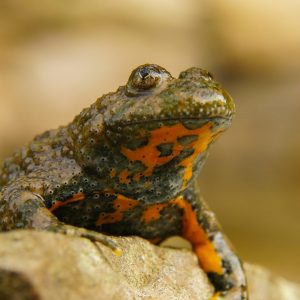Copyright 2021 Evolution Reptiles
All rights reserved.
Copyright 2025 Evolution Reptiles
All rights reserved.
All rights reserved.
A member of one of the most popular species groups of amphibian in the pet trade, the yellow bellied toad (which is technically a frog) has been introducing people to the joys of amphibian keeping for many years. It is just one of six species that are collectively known as fire bellied toads, although the underside of this species is definitely yellow!

Yellow bellies tend to be grey-brown on the top, with a very dark underbelly marked with a pattern of bright yellow spots or blotches. They also have a distinctive behaviour called the ‘unken reflex’ which is a method of showing their bright underside to possible predators; it’s a warning that they taste bad, and are in fact quite toxic to eat. However, as long as you wash your hands well both before and after handling your frog you will be fine – just don’t put it in your mouth!
Yellow bellied toads can be found across central and southern Europe, in hilly areas with a moderate climate. They are semi-aquatic and live in a variety of habits, from forest streams and marshes to more disturbed areas such as fields and drainage ditches.
For the smallest frog in the group (they reach around 5cm in length), the yellow belly is remarkably confident and bold. They are happy to live in groups, and soon learn to anticipate the arrival of their keeper with food – in fact, they are so good at this that obesity is a very common health issue with them!
Not only are they diurnal (active during the day) and outgoing, but yellow bellies positively thrive when kept in groups. A terrarium of at least 45 x 45 x 30cm is fine for a trio, although bigger is always better. A 60 x 45 x 30cm could comfortably house four or even five frogs, and so on. They are happy with either a large water bowl or a semi aquatic setup.
As a diurnal amphibian it’s very important to provide a source of UV light. They don’t need the high levels that a midday basker like the bearded dragon does, but they do need it. A compact bulb or a low output T5 tube are both fine, and it’s important to make sure that they have enough shade to regulate their exposure. They’re not fans of excessively high temperatures, either; although they are not as sensitive as some salamanders, they find high temperatures uncomfortable and can become distressed at temperatures above 30ºC. A heat gradient should be provided within their enclosure, and this can be accomplished by use of either low power heat bulbs or deep heat projectors, both of which should be used with a thermostat. Always use a digital thermometer to keep an eye on your temperatures.
Feeding is simple, as they can be quite greedy frogs. Anything that moves that they think they can fit in their mouths will be tackled, so it’s important to remember not to give them prey items that are too large. Offer them a variety of small food items, which should be gut loaded and dusted with a good quality multivitamin/multimineral or calcium supplement. They will thrive on a diet based around crickets, locusts, mealworms, small roaches with the occasional treat of a waxworm; they will also enjoy small moths, spiders, and anything else that they can catch!
Very common within the trade, they are still usually available as wild caught individuals. If at all possible, search out captive bred ones; they will be used to people, already know what food items they can eat, and are much less likely to carry parasites or bacterial or fungal disease. It’s worth paying a little extra for a captive bred toad!
Common name: Yellow Bellied Toad
Scientific Name: Bombina variegata
Location: Central and southern Europe
Habitat (wild): Fields, mountain streams, forest pools
Captive environment: Temperate to tropical terrestrial terrarium, riparium or paludarium
Preferred temperature range: 24ºc to 26ºc with a temperature drop at night
Ferguson Zone: Zone 1
UVB: 5% or 7% tube or compact bulb
Substrate: Coir fibre mixed with sphagnum moss, leaf litter, leaf mulch
Lifespan: Up to 20 years
Copyright 2021 Evolution Reptiles
All rights reserved.